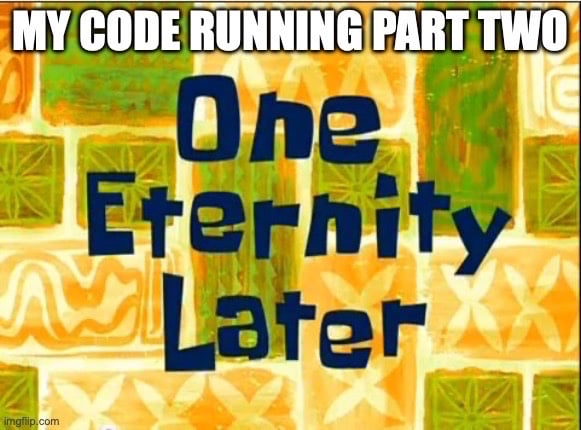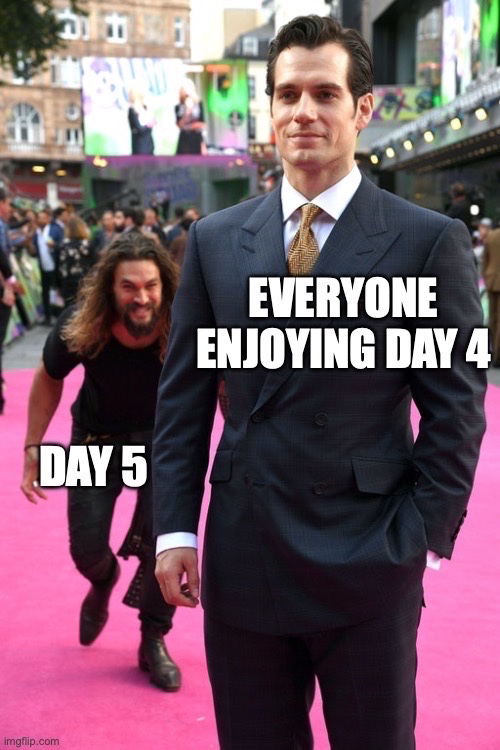What does “zoomed in to check which colour they re-used in the second chart so didn’t even realise there was a third one” count as?
Isn’t every video game just moving colourful blocks?
(Except Quake obviously)
i_understood_that_reference.jif
Dad mode activated
Dart
~~I'm cheating a bit by posting this as it does take 11s for the full part 2 solution, but having tracked down and eliminated the excessively long path for part 1, I can't be bothered to do it again for part 2.~~
I'm an idiot. Avoiding recursively adding the same points to the seen set dropped total runtime to a hair under 0.5s, so line-seconds are around 35.
Map, Set>> seen = {};
Map fire(List> grid, Point here, Point dir) {
seen = {};
return _fire(grid, here, dir);
}
Map, Set>> _fire(
List> grid, Point here, Point dir) {
while (true) {
here += dir;
if (!here.x.between(0, grid.first.length - 1) ||
!here.y.between(0, grid.length - 1)) {
return seen;
}
if (seen[here]?.contains(dir) ?? false) return seen;
seen[here] = (seen[here] ?? >{})..add(dir);
Point split() {
_fire(grid, here, Point(-dir.y, -dir.x));
return Point(dir.y, dir.x);
}
dir = switch (grid[here.y][here.x]) {
'/' => Point(-dir.y, -dir.x),
r'\' => Point(dir.y, dir.x),
'|' => (dir.x.abs() == 1) ? split() : dir,
'-' => (dir.y.abs() == 1) ? split() : dir,
_ => dir,
};
}
}
parse(List lines) => lines.map((e) => e.split('').toList()).toList();
part1(List lines) =>
fire(parse(lines), Point(-1, 0), Point(1, 0)).length;
part2(List lines) {
var grid = parse(lines);
var ret = 0.to(grid.length).fold(
0,
(s, t) => [
s,
fire(grid, Point(-1, t), Point(1, 0)).length,
fire(grid, Point(grid.first.length, t), Point(-1, 0)).length
].max);
return 0.to(grid.first.length).fold(
ret,
(s, t) => [
s,
fire(grid, Point(t, -1), Point(0, 1)).length,
fire(grid, Point(t, grid.length), Point(0, -1)).length
].max);
}
That’s why I normally let computers do my sums for me. Corrected now.
Dart
Just written as specced. If there's any underlying trick, I missed it totally.
9ms * 35 LOC ~= 0.35, so it'll do.
int decode(String s) => s.codeUnits.fold(0, (s, t) => ((s + t) * 17) % 256);
part1(List lines) => lines.first.split(',').map(decode).sum;
part2(List lines) {
var rules = lines.first.split(',').map((e) {
if (e.contains('-')) return ('-', e.skipLast(1), 0);
var parts = e.split('=');
return ('=', parts.first, int.parse(parts.last));
});
var boxes = Map.fromEntries(List.generate(256, (ix) => MapEntry(ix, [])));
for (var r in rules) {
if (r.$1 == '-') {
boxes[decode(r.$2)]!.removeWhere((l) => l.$1 == r.$2);
} else {
var box = boxes[decode(r.$2)]!;
var lens = box.indexed().firstWhereOrNull((e) => e.value.$1 == r.$2);
var newlens = (r.$2, r.$3);
(lens == null) ? box.add(newlens) : box[lens.index] = newlens;
}
}
return boxes.entries
.map((b) =>
(b.key + 1) *
b.value.indexed().map((e) => (e.index + 1) * e.value.$2).sum)
.sum;
}
Dart
Big lump of code. I built a general slide function which ended up being tricksy in order to visit rocks in the correct order, but it works.
int hash(List> rocks) =>
(rocks.map((e) => e.join('')).join('\n')).hashCode;
/// Slide rocks in the given (vert, horz) direction.
List> slide(List> rocks, (int, int) dir) {
// Work out in which order to check rocks for most efficient movement.
var rrange = 0.to(rocks.length);
var crange = 0.to(rocks.first.length);
var starts = [
for (var r in (dir.$1 == 1) ? rrange.reversed : rrange)
for (var c in ((dir.$2 == 1) ? crange.reversed : crange)
.where((c) => rocks[r][c] == 'O'))
(r, c)
];
for (var (r, c) in starts) {
var dest = (r, c);
var next = (dest.$1 + dir.$1, dest.$2 + dir.$2);
while (next.$1.between(0, rocks.length - 1) &&
next.$2.between(0, rocks.first.length - 1) &&
rocks[next.$1][next.$2] == '.') {
dest = next;
next = (dest.$1 + dir.$1, dest.$2 + dir.$2);
}
if (dest != (r, c)) {
rocks[r][c] = '.';
rocks[dest.$1][dest.$2] = 'O';
}
}
return rocks;
}
List> oneCycle(List> rocks) =>
[(-1, 0), (0, -1), (1, 0), (0, 1)].fold(rocks, (s, t) => slide(s, t));
spin(List> rocks, {int target = 1}) {
var cycle = 1;
var seen = {};
while (cycle != target) {
rocks = oneCycle(rocks);
var h = hash(rocks);
if (seen.containsKey(h)) {
var diff = cycle - seen[h]!;
var count = (target - cycle) ~/ diff;
cycle += count * diff;
seen = {};
} else {
seen[h] = cycle;
cycle += 1;
}
}
return weighting(rocks);
}
parse(List lines) => lines.map((e) => e.split('').toList()).toList();
weighting(List> rocks) => 0
.to(rocks.length)
.map((r) => rocks[r].count((e) => e == 'O') * (rocks.length - r))
.sum;
part1(List lines) => weighting(slide(parse(lines), (-1, 0)));
part2(List lines) => spin(parse(lines), target: 1000000000);
Dart
Just banging strings together again. Simple enough once I understood that the original reflection may also be valid after desmudging. I don't know if we were supposed to do something clever for part two, but my part 1 was fast enough that I could just try every possible smudge location and part 2 still ran in 80ms
bool reflectsH(int m, List p) => p.every((l) {
var l1 = l.take(m).toList().reversed.join('');
var l2 = l.skip(m);
var len = min(l1.length, l2.length);
return l1.take(len) == l2.take(len);
});
bool reflectsV(int m, List p) {
var l1 = p.take(m).toList().reversed.toList();
var l2 = p.skip(m).toList();
var len = min(l1.length, l2.length);
return 0.to(len).every((ix) => l1[ix] == l2[ix]);
}
int findReflection(List p, {int butNot = -1}) {
var mirrors = 1
.to(p.first.length)
.where((m) => reflectsH(m, p))
.toSet()
.difference({butNot});
if (mirrors.length == 1) return mirrors.first;
mirrors = 1
.to(p.length)
.where((m) => reflectsV(m, p))
.toSet()
.difference({butNot ~/ 100});
if (mirrors.length == 1) return 100 * mirrors.first;
return -1; //never
}
int findSecondReflection(List p) {
var origMatch = findReflection(p);
for (var r in 0.to(p.length)) {
for (var c in 0.to(p.first.length)) {
var pp = p.toList();
var cells = pp[r].split('');
cells[c] = (cells[c] == '#') ? '.' : '#';
pp[r] = cells.join();
var newMatch = findReflection(pp, butNot: origMatch);
if (newMatch > -1) return newMatch;
}
}
return -1; // never
}
Iterable> parse(List lines) => lines
.splitBefore((e) => e.isEmpty)
.map((e) => e.first.isEmpty ? e.skip(1).toList() : e);
part1(lines) => parse(lines).map(findReflection).sum;
part2(lines) => parse(lines).map(findSecondReflection).sum;
Imagine you're looking at a grid with your path drawn out on it. On any given row, start from the left and move right, cell by cell. You're outside the area enclosed by your path at the start of the row. As you move across that row, you remain outside it until you meet and cross the line made by your path. Every non-path cell you now pass can be added to your 'inside' count, until you next cross your path, when you stop counting until you cross the path again, and so on.
In this problem, you can tell you're crossing the path when you encounter one of:
- a '|'
- a 'F' (followed by 0 or more '-'s) followed by 'J'
- a 'L' (followed by 0 or more '-'s) followed by '7'
If you encounter an 'F' (followed by 0 or more '-'s) followed by '7', you've actually just skimmed along the line and not actually crossed it. Same for the 'L'/ 'J' pair.
Try it out by hand on the example grids and you should get the hang of the logic.
Uiua
As promised, just a little later than planned. I do like this solution as it's actually using arrays rather than just imperative programming in fancy dress. Run it here
Grid ← =@# [
"...#......"
".......#.."
"#........."
".........."
"......#..."
".#........"
".........#"
".........."
".......#.."
"#...#....."
]
GetDist! ← (
# Build arrays of rows, cols of galaxies
⊙(⊃(◿)(⌊÷)⊃(⧻⊢)(⊚=1/⊂)).
# check whether each row/col is just space
# and so calculate its relative position
∩(\++1^1=0/+)⍉.
# Map galaxy co-ords to these values
⊏:⊙(:⊏ :)
# Map to [x, y] pairs, build cross product,
# and sum all topright values.
/+≡(/+↘⊗0.)⊠(/+⌵-).⍉⊟
)
GetDist!(×1) Grid
GetDist!(×99) Grid



We stayed in Sheerness (where this flight took place), and when my girlfriend saw this she immediately asked “Did pigs fly before women did?”. And the answer turned out to be no, women beat pigs by two weeks: “Sarah Van Deman … was the woman who flew with Wilbur Wright on October 27, 1909” source